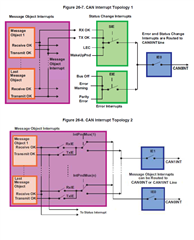Hi Experts,
According to the thread I linked to, how can both interrupt lines be used at the same time?
In my code, CANINT0 is for checking the TxOk status for transmitting packets, so I know if my message is transmitted successfully. I also want to get an interrupt when a packet is received by CANINT1's global interrupt. However, I do not get any interrupts when a message object is received. How can I fix this?
Here are a few parts of my code:
void CAN_init(void)
{
//CAN initialization
CAN_initModule(CAN_BASE);
// Refer to the Driver Library User Guide for information on how to set
// tighter timing control. Additionally, consult the device data sheet
// for more information about the CAN module clocking.
//
CAN_setBitRate(CAN_BASE, DEVICE_SYSCLK_FREQ, 100000, 20);
// Enable CAN Interrupts
CAN_enableInterrupt(CAN_BASE, CAN_INT_IE1|CAN_INT_STATUS);
CAN_enableGlobalInterrupt(CAN_BASE, CAN_GLOBAL_INT_CANINT1);
// Initialize the transmit message object used for sending CAN messages.
// Message Object Parameters:
// Message Object ID Number: 1
// Message Identifier: 1
// Message Frame: CAN_MSG_FRAME_STD
// Message Type: CAN_MSG_OBJ_TYPE_RX
// Message ID Mask: 0
// Message Object Flags: CAN_MSG_OBJ_RX_INT_ENABLE
// Message Data Length: 8 Bytes
//
CAN_setupMessageObject(CAN_BASE, 1, 1, CAN_MSG_FRAME_STD,CAN_MSG_OBJ_TYPE_RX, 0, CAN_MSG_OBJ_RX_INT_ENABLE,8);
// Initialize the transmit message object used for sending CAN messages.
// Message Object Parameters:
// Message Object ID Number: 2
// Message Identifier: 2
// Message Frame: CAN_MSG_FRAME_STD
// Message Type: CAN_MSG_OBJ_TYPE_TX
// Message ID Mask: 0
// Message Object Flags: CAN_MSG_OBJ_TX_INT_ENABLE
// Message Data Length: 8 Bytes
//
CAN_setupMessageObject(CAN_BASE, 2, 2, CAN_MSG_FRAME_STD,CAN_MSG_OBJ_TYPE_TX, 0, CAN_MSG_OBJ_TX_INT_ENABLE,8);
CAN_setInterruptMux(CAN_BASE, 2); <-----------to use CANINT1 for msg obj 1
//
// Start CAN module operations
//
CAN_startModule(CAN_BASE);
};
CANINT1 is the only interrupt I enable:
//
// This registers the interrupt handler in PIE vector table.
//
Interrupt_register(INT_CANB1, &ISR_can1);
//
// Enable the CAN-B interrupt signal
//
Interrupt_enable(INT_CANB1);
I use the following code to verify successful transmission:
bool canGetTxOkStatus(void)
{
uint16_t status;
status = CAN_getStatus(CAN_BASE);
if ( (status & CAN_STATUS_TXOK) == CAN_STATUS_TXOK)
{
return true;
}
else
{
return false;
}
}



